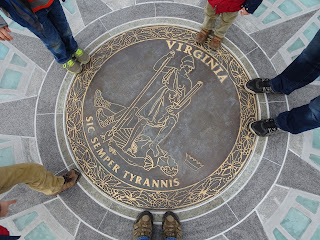Not
far from the bank of the James River is the Virginia State Capitol, home to the
oldest legislative body in the Western Hemisphere, the Virginia General
Assembly (first established as the House of Burgesses in 1619). Virginia's
original capitol was actually Jamestown, and Virginia saw a total of seven other
capitol buildings there and in Williamsburg, the Capitol until the American
Revolutionary War. However, the Richmond Capitol building was completed in 1788 and has been in use ever since (with the exception of a couple days in 1865 as I mention further in the post).
Thomas
Jefferson and Charles-Louis Clérisseau designed the Capitol building, modeled after an ancient Roman temple in Nîmes, France: the Maison
Carrée. Intended as a departure from traditional English architecture as a
form of protest, the architecture is considered to be in the Early
Republic, Palladian style. (For a look at the Maison Carrée, check out my post on Nîmes, and for another historic design by Thomas Jefferson, I wrote this post on Monticello!)
During
the Civil War the building also served as the Capitol of the Confederacy.
Possibly due to its location on Shockoe Hill, the Capitol (along with the
neighboring VA Governor's Mansion & White House of the Confederacy) were somehow
spared destruction while the city burned during the Confederate evacuation in
April 1865. During the days that separated this evacuation from the fall of the
Confederacy, Lynchburg served as the Capital of Virginia; it was during
this time that President Abraham Lincoln toured the Capitol – only about a week
before his assassination in DC.
During
the period of Reconstruction Virginia was under military rule. In the months following
the end of military control, the Virginia Supreme Court of Appeals held a
hearing on the dispute over leadership of the Richmond government. On April 27,
1870 as hundreds of people crowded into the building, the balcony buckled,
falling to the courtroom floor – which then collapsed into the House of
Delegates chamber, some 40 feet below. 62 people were killed and another 251
injured, a grandson of Patrick Henry among the dead.
However,
the necessary repairs were made, and in 1904 two additional wings that were not
in the original plan were added to provide space for the legislature. In 1960 the
structure acquired National Historic Landmark status. More recently in 2007 a
$100 million renovation was completed, updating the HVAC, mechanical & plumbing,
as well as adding a 27,000 sq. ft. space under the south lawn. This expansion
serves as a modern-day visitor’s entrance and contains additional office space
and meeting rooms.
Capitol
Square features multiple monuments to prominent Virginians and events in
Virginia, including the 1858 Virginia Washington Monument. The states around
the base include Patrick Henry, Thomas Jefferson, Andrew Lewis, John Marshall, George
Mason and Thomas Nelson Jr. Nearby is a ‘Zero Milestone’ statue that measures
highway distances from the city of Richmond (1929).
Along
the north end are a line of statues. The General Thomas J.
"Stonewall" Jackson statue was installed in 1875, and Governor
William Smith’s statue in 1906. The Dr. Hunter Holmes McGuire Statue dates to
1904. There is also a statue dedicated to Harry F. Byrd Sr. (1976), and
finally, the newest addition to Capitol Square is the Virginia Civil Rights
Memorial (2008).
In the
southwest corner stands the Bell Tower, construction of which was finished in 1825.
Still used for ceremonial ringing, it now houses a Visitor Center. Nearby is the
Edgar Allan Poe statue (1958) which commemorates the writer’s time living in
Richmond. The Oliver Hill Building was finished
in 1894.
Free guided
tours of the Capitol building are available; the one hour tour includes the underground
Capitol Extension and Rotunda, Jefferson Room, Old House Chamber & Old Senate
Chamber, and the present-day legislative chambers located in the 1906 wings
(when the General Assembly is not in session). Tours run Monday through
Saturday starting at 10am for walk-in visitors (9am for groups by appointment) and going until 4pm.
Sunday tours and self-guided tours are also available; see Virginia General
Assembly website for details.









No comments:
Post a Comment